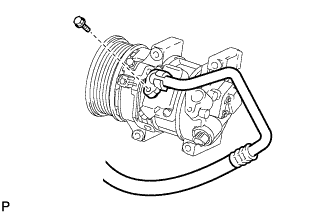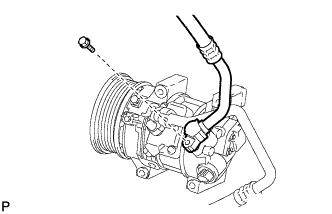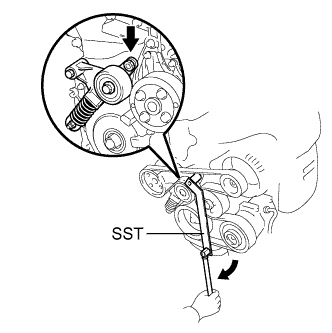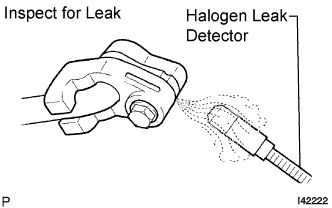Compressor (For 2Az-Fe) -- Installation |
| 1. ADJUST COMPRESSOR OIL LEVEL |
When replacing the cooler compressor assembly with a new one, gradually discharge the inert gas (helium) from the service valve, and drain the following amount of oil from the vents indicated by the arrows in the illustration before installation.
- HINT:
- The drain bolt and washer can be reused.
- Standard:
- (Oil capacity inside the new compressor: 90 + 15 cc (3 + 0.51 fl.oz.)) - (Remaining oil amount in the removed compressor) = (Oil amount to be removed from the new compressor when replacing)
- NOTICE:
- If a new compressor is installed without removing some oil remaining in the pipes of the vehicle, the oil amount will be excessive. This prevents heat exchange in the refrigerant cycle and causes refrigeration system failure.
- If the volume of oil remaining in the removed compressor is too small, check for oil leaks.
- Be sure to use ND-OIL 8 or equivalent for compressor oil.
 |
| 2. INSTALL COMPRESSOR ASSEMBLY WITH PULLEY |
Using a "TORX" socket wrench (E8), install the compressor assembly with pulley with the 2 stud bolts.
- Torque:
- 9.8 N*m{100 kgf*cm, 87 in.*lbf}
 |
Install the compressor assembly with pulley with the 2 bolts and the 2 nuts.
- HINT:
- Tighten the bolts and the nuts in the order shown in the illustration.
- Torque:
- 25 N*m{255 kgf*cm, 18 ft.*lbf}
 |
Connect the connector.
| 3. CONNECT DISCHARGE HOSE SUB-ASSEMBLY |
Remove the attached vinyl tape from the hose.
Apply sufficient compressor oil to a new O-ring and the fitting surface of the compressor assembly with pulley.
- Compressor oil:
- ND-OIL 8 or equivalent
Install the O-ring onto the discharge hose sub-assembly.
Install the discharge hose sub-assembly onto the compressor assembly with pulley with the bolt.
- Torque:
- 9.8 N*m{100 kgf*cm, 87 in.*lbf}
 |
| 4. CONNECT SUCTION HOSE SUB-ASSEMBLY |
Remove the attached vinyl tape from the hose.
Apply sufficient compressor oil to a new O-ring and the fitting surface of the compressor assembly with pulley.
- Compressor oil:
- ND-OIL 8 or equivalent
Install the O-ring onto the suction hose sub-assembly.
Install the suction hose sub-assembly onto the compressor assembly with pulley with the bolt.
- Torque:
- 9.8 N*m{100 kgf*cm, 87 in.*lbf}
 |
| 5. INSTALL V-RIBBED BELT |
 |
- HINT:
- The illustration shows the V-ribbed belt layout.
Using SST, slowly turn the V-ribbed belt tensioner clockwise and install the V-ribbed belt.
- SST
- 09216-42010(09216-04010)
- NOTICE:
- Make sure that SST and other tools are set to the tensioner securely.
- When compressing the V-ribbed belt tensioner, slowly turn the tensioner.
 |
| 6. INSTALL ENGINE UNDER COVER RH |
| 7. CHARGE WITH REFRIGERANT |
Perform vacuum purging using a vacuum pump.
Charge with refrigerant HFC-134a (R134a).
- Standard:
- 410 to 470 g (14.5 to 16.6 oz.)
- SST
- 09985-20010(09985-02130,09985-02150,09985-02090,09985-02110,09985-02010,09985-02050,09985-02060,09985-02070,09985-02140,09985-02080)
- NOTICE:
- Do not turn the A/C on before charging with refrigerant. Doing so will cause the cooler compressor to work without refrigerant, resulting in overheating of the cooler compressor.
- HINT:
- Ensure that sufficient refrigerant is available to recharge the system when using a refrigerant recovery unit. Refrigerant recovery units are not always able to recover 100% of the refrigerant from an A/C system.
| 8. WARM UP ENGINE |
Keep the A/C switch on for at least 2 minutes to warm up the compressor.
- NOTICE:
- Be sure to warm up the compressor when turning the A/C on after removing and installing the cooler refrigerant lines (including the compressor), to prevent damage to the compressor.
| 9. INSPECT FOR REFRIGERANT LEAK |
After recharging with refrigerant, inspect for refrigerant leaks using a halogen leak detector.
Carry out the test under the following conditions:
- Turn the ignition switch off.
- Secure good ventilation (the halogen leak detector may react to volatile gases which are not refrigerant, such as evaporated gasoline and exhaust gas).
- Repeat the test 2 or 3 times.
- Make sure that there is some refrigerant remaining in the refrigeration system.
When the compressor is off: approx. 392 to 588 kPa (3.9 to 5.9 kgf/cm2, 57 to 85 psi).
- Turn the ignition switch off.
Using a halogen leak detector, inspect for refrigerant leaks from the refrigerant lines.
 |
Bring the halogen leak detector close to the drain hose with the detector's power off, and then turn the detector on.
- HINT:
- After the blower motor has stopped, let the cooling unit stand for more than 15 minutes.
- Bring the halogen leak detector sensor under the drain hose.
- When bringing the halogen leak detector close to the drain hose, make sure that the halogen leak detector does not react to volatile gases.
If it is not possible to avoid interference from volatile gases, the vehicle should be lifted up to allow testing.
 |
If a refrigerant leak is not detected from the drain hose, remove the blower motor control from the cooling unit. Insert the halogen leak detector sensor into the unit and perform the test.
Disconnect the pressure switch connector and leave it for approximately 20 minutes. Bring the halogen leak detector close to the pressure switch and perform the test.